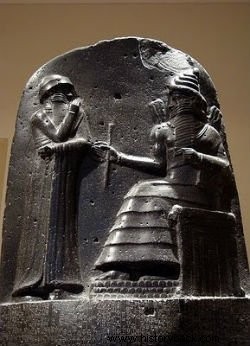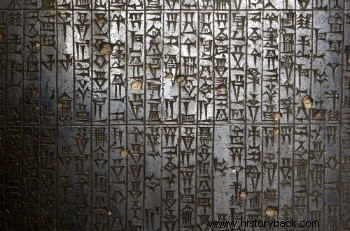The Code of Hammurabi is a set of laws that were created around 1780 BC. in Mesopotamia.
It gets its name because it is associated with the sixth Sumerian king, founder of the First Babylonian Empire, Hammurabi.
History

In one of the columns where part of the Code is written, Hammurabi receives the Code from the hands of the god Samas, the god Sun and Justice
Who was Hammurabi?
Hammurabi was born around 1810 BC. and died in 1750 BC. He was the sixth ruler of the dynasty of Babylonian kings. His reign lasted more than 40 years and, despite his military conquests, he is remembered for his interpretation of justice that aimed to organize the people.
Likewise, he tried to institute the cult of a single god as a way of unifying the different religions of his subjects. He did not succeed, but at least he established that the Sun god, Shamash (or Samas ) should be adored by everyone.
Before the Code of Hammurabi, other codes already existed in Mesopotamia, such as the UR-Nammu Code, which emphasized pecuniary compensation for crimes committed and not the law of talion.
Law of Talion
The law of talion can be summed up in the famous verse found in the Book of Leviticus “an eye for an eye, a tooth for a tooth ”. This means that every crime committed would have a proportional punishment.
Although it is considered in the 21st century as a primitive or exaggerated law, the truth is that this law can be considered an advance within its historical context.
Before it, the victim could carry out his revenge personally and in any way he saw fit. With talion law, the penalty should be appropriate to the crime and carried out by a specific institution.
Characteristics
In the Code of Hammurabi, the laws were not equitable, as the application varied whether the individual was free, slave or servant, male or female.
In order to implement justice, the legal code was also used in Ancient Greece and Rome. Until the present day they serve as inspiration for the elaboration of the rights, duties and obligations of citizens.
In the work's epilogue, we can check the king's words:
Laws of the Code of Hammurabi:Summary
Hammurabi's Code was carved out of a large diorite rock 2.25 meters high, 1.60 meters in circumference at the top and 1.90 meters at the base.
It was made up of 282 ancient Babylonian laws arranged in 46 columns with about 3600 lines in Akkadian cuneiform script.
It was found by French archaeologists in the early 20th century in the city of Susa, Iran, and translated into several languages.
The original is currently in the Louvre Museum in Paris.
 Detail of Hammurabi's Code
Detail of Hammurabi's Code
The text deals with various subjects such as:social classes, commerce, property, family, work, theft, law of retribution (an eye for an eye, a tooth for a tooth), rape, death penalty, etc.
Check out the topics of the articles below:
I - Spells, judgment of God, false witness, prevarication of judges;
II - Crimes of theft and robbery, claim of furniture;
III - Rights and duties of officers, gregarious and vassals in general, benefit organization;
IV - Leases and general regime of rustic funds, mutual, rental of houses, payment in kind;
V - Relations between traders and commissioners;
VI - Regulations of taverns (dedicated taverns, police, penalties and tariffs);
VII - Obligations (transport contracts, mutual) enforcement process and debt bondage;
VIII - Deposit agreements;
IX - Injury and defamation;
X - Marriage and family, crimes against the family order, nuptial contributions and donations, succession;
XI - Adoption, offenses to parents, child replacement;
XII - Offenses and penalties (bodily injuries, retaliation, compensation and composition);
XIII - Doctors and veterinarians; architects and boatmen (salaries, fees and liability) crash of vessels;
XIV - Kidnapping, animal leasing, field farmers, shepherds, workers. Damage, theft of harnesses, water, slaves (redemptive action, responsibility for eviction, discipline).
See here the complete Code of Hammurabi in pdf.
Curiosities
- The Code of Hammurabi is one of the oldest legal documents related to human rights.
- There is no documentary evidence that the code was applied, but it was certainly copied and studied by later generations.
- Among the strangest laws we found in the code the one that dictated the brewer's drowning in his own drink, if it was bad.
Read more:
- Babylonian Empire
- Sumerians
- Mesopotamian Civilizations
- Ancient Rome
- People of Mesopotamia
- Questions about Mesopotamia
